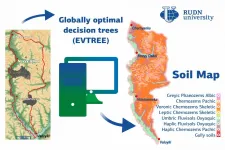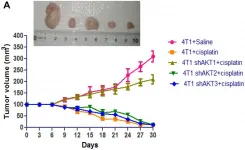(Press-News.org) It does not happen often. But on rare occasions, physicians make mistakes and may make a wrong diagnosis. Patients may have many diseases all at once, where it can be difficult to distinguish the symptoms of one illness from the other, or there may be a lack of symptoms.
Errors in diagnosis may lead to incorrect treatment or a lack of treatment. Therefore, everyone in the healthcare system tries to minimise errors as much as possible.
Now, researchers at the University of Copenhagen have developed an algorithm that can help with just that.
'Our new algorithm can find the patients who have such an unusual disease trajectory that they may indeed not suffer from the disease they were diagnosed with. It can hopefully end up being a support tool for physicians', says Isabella Friis Jørgensen, Postdoc at the Novo Nordisk Foundation Center for Protein Research.
The algorithm revealed possible lung cancer
The researchers have developed the algorithm based on disease trajectories for 284,000 patients with chronic obstructive pulmonary disease (COPD), from 1994 to 2015. Based on these data, they came up with approximately 69,000 typical disease trajectories.
'In the National Patient Registry, we have been able to map what you could call typical disease trajectory. And if a patient shows up with a very unusual disease trajectory, then it might be that the patient is simply suffering from a different disease. Our tool can help to detect this', explains Søren Brunak, Professor at the Novo Nordisk Foundation Center for Protein Research.
For example, the researchers found a small group of 2,185 COPD patients who died very shortly after being diagnosed with COPD. According to the researchers, it was a sign that something else might have been wrong, maybe something even more serious.
'When we studied the laboratory values from these patients more closely, we saw that they deviated from normal values for COPD patients. Instead, the values resembled something that is seen in lung cancer patients. Only 10 per cent of these patients were diagnosed with lung cancer, but we are reasonably convinced that most, if not all of these patients actually had lung cancer', explains Søren Brunak.
Data that will provide an immediate benefit
Although the algorithm was validated through data from COPD patients, it may be used for many other diseases. The principle is the same: the algorithm uses registry data to map the typical disease trajectories and can detect if some patients' disease trajectory stand out so much that something may be wrong.
'Naturally, our most important goal is for the patients to get their money's worth with respect to their health care. And we believe that in the future, this algorithm may end up becoming a support tool for physicians. Once the algorithm has mapped the typical disease trjaectories, it only takes 10 seconds to match a single patient against everyone else', says Søren Brunak.
He emphasises that the algorithm must be further validated and tested in clinical trials before it can be implemented in Danish hospitals. But he hopes it is something that can be started soon.
'In Denmark, we often praise our good health registries because they contain valuable data for researchers. We use them in our research because it may benefit other people in the future in the form of better treatment. But this is actually an example of how your own health data can benefit yourself right away', says Søren Brunak.
INFORMATION:
Scientists have discovered that pollution concentration varies between seasons. A new study, conducted in the North China Plain, determined where volatile organic compounds (VOCs) are distributed within the vertical layers of the atmosphere, and found notable changes from winter to summer.
"The concentration of VOCs in the vertical direction was much higher in winter than that in summer and their emission sources showed different contributions in both seasons," said Guiqian Tang, associate professor in the Institute of Atmospheric Physics, Chinese Academy of Sciences, and the corresponding author of a study just published in Advances in Atmospheric Sciences .
The researchers conducted a field campaign from June 8 to July 3, 2019. They focused ...
Researchers have used the zebrafish (Danio rerio) to identify the role of a gene involved in cardiac rhythm, which could help explain the fundamentals of what it takes to make a human heartbeat.
The University of Melbourne study also found that mutation of the gene, Tmem161b, causes potentially fatal cardiac arrhythmia. 2.5 per cent of Australians are living with cardiac arrhythmia ( END ...
Almost half of people testing positive for coronavirus have reported symptoms of depression, according to a new study published in the International Journal of Environmental Research and Public Health.
Researchers from Bangladesh, the United States and Anglia Ruskin University (ARU) in the UK carried out a cross-sectional survey of more than 1,000 Bangladeshi adult coronavirus patients over the course of one month.
A total of 48% of respondents were categorised as having moderate to severe depression, with a higher prevalence in those with persistent symptoms, low family income ...
Brain tumours are the most common solid tumours in childhood and the largest cause of death from cancer in this age group
Being able to classify a brain tumour's type, without the use of biopsy, is hard to do; however diffusion weighted imaging, an advanced imaging technique, when combined with machine learning, can help a UK-based multi-centre study, including WMG, University of Warwick has found.
Being able to characterise the tumour(s) faster and more accurately means they can be treated more efficiently
Diffusion weighted imaging and machine learning can successfully classify the diagnosis and characteristics of common types of paediatric brain tumours a UK-based multi-centre study, including WMG at the University of Warwick ...
Researchers from North Carolina State University, Boston University and Kraton Corporation have demonstrated a family of self-sterilizing polymers that are effective at inactivating coronaviruses, including SARS-CoV-2 - the virus that causes COVID-19. The work opens the door to a suite of applications that could help to reduce the transmission of COVID-19 and other diseases.
"Our work here provides conclusive evidence that these materials, anionic polymers, can inactivate human coronaviruses quickly and efficiently," says Richard Spontak, co-author of a paper on the work accepted for publication in Advanced Science. Spontak is a Distinguished Professor of Chemical and Biomolecular Engineering and ...
A team of soil scientists developed a new approach to the automatic generation and updating of soil maps. Having applied machine learning technologies to a set of rules traditionally used by experts in manual mapping, the team obtained a highly accurate model that provides easy-to-interpret results. The study was published in ISPRS International Journal of Geo-Information.
Many software solutions for digital soil mapping are based on statistical models. The accuracy of such programs is limited because statistical models depend on the quality and quantity of field data and can ignore local irregularities in soil properties. It is difficult to obtain accurate and useful information from ...
TAMPA, Fla. - One of the most challenging issues in cancer therapy is the development of drug resistance and subsequent disease progression. In a new article featured on this month's cover of Cancer Research, Moffitt Cancer Center researchers, in collaboration with Oxford University, report results from their study using mathematical modeling to show that cell turnover impacts drug resistance and is an important factor that governs the success of adaptive therapy.
Cancer treatment options have increased substantially over the past few decades; however, many patients eventually develop drug resistance. Physicians strive to overcome resistance by either trying to target cancer cells through an alternative approach or targeting the resistance mechanism itself, but success with ...
Oncotarget recently published "Targeting an engineered cytokine with interleukin-2 and interleukin-15 activity to the neovasculature of solid tumors" by Mortensen, et al. which reported that there is a growing interest in the antibody-based delivery of cytokines to the tumor environment as a means to boost the anti-cancer activity of tumor-resident T cells and NK cells.
Here, the authors described the expression and characterization of fusion proteins, featuring the L19 antibody and an engineered cytokine with interleukin-2 and interleukin-15 ...
Oncotarget recently published "AKT isoforms have discrete expression in triple negative breast cancers and roles in cisplatin sensitivity" which reported that the authors investigated the expression and net effect of the individual isoforms in triple negative breast cancers and response to cisplatin treatment using cellular, mice models and clinical samples.
Interestingly, analysis of the expressions of AKT isoforms in clinical samples showed relatively higher expression of AKT1 in primary tissues; whereas lung and liver metastatic samples showed elevated ...
Coffee, cola or an energy drink: caffeine is the world's most widely consumed psychoactive substance. Researchers from the University of Basel have now shown in a study that regular caffeine intake can change the gray matter of the brain. However, the effect appears to be temporary.
No question - caffeine helps most of us to feel more alert. However, it can disrupt our sleep if consumed in the evening. Sleep deprivation can in turn affect the gray matter of the brain, as previous studies have shown. So can regular caffeine consumption affect brain structure due to poor sleep? A research team led by Dr. Carolin Reichert and Professor Christian Cajochen of the University of Basel ...



